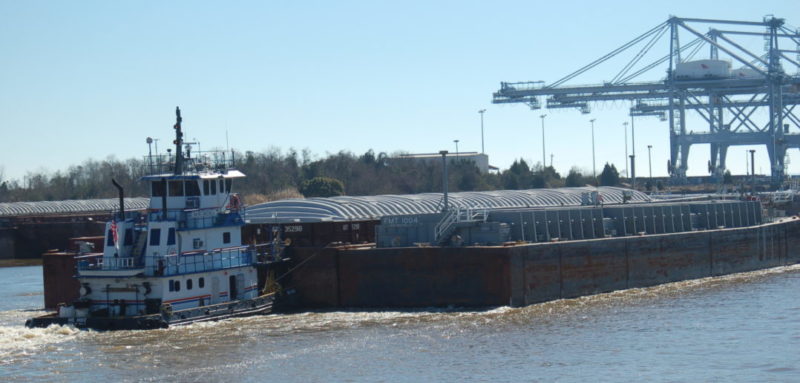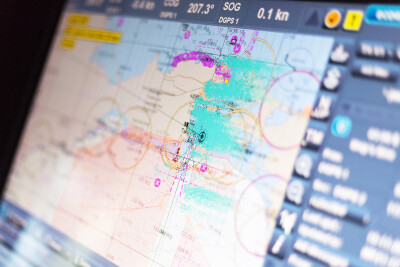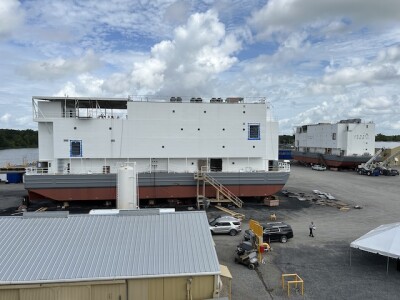The inland waterways are enjoying a healthy infusion of federal support for building and maintaining an aging lock and dam system, but unprecedented Midwest flooding and an ongoing trade war with China are taking a toll on river transportation, the head of the Waterways Council Inc. said on Monday.
As a result of a formula change made by Congress in 2014 to the Inland Waterways Trust Fund (IWTF), which covers the cost of new infrastructure spending on the rivers, more money has become available to finish the much-delayed Olmsted Lock and Dam project along the Ohio River and to jump start several other key river projects, Michael Toohey, WCI president and CEO, said at a press briefing. This was achieved by changing the cost formula from 50-50 industry/federal funds to 85% federal and 15% industry.
“We’ve had delivery of more projects for less money,” he said, adding that investments in operations and maintenance have reduced the number of unscheduled closures of locks and dams for repairs, which create operational headaches and delays for barge operators and their customers.
At the same time, waterways advocates have been able to thwart proposals that would have imposed new tolls and lockage fees on the barge operators for using the rivers, while not charging other users, Toohey said.
There have been encouraging signs that Congress and the Trump administration are committed to a broad federal initiative to improve America’s crumbling infrastructure, including waterways, but the administration has offered disappointing budgets that fall short of meeting these goals.
“There’s a disconnect between the infrastructure initiative support and what (Trump) said when he came to the Ohio River (in 2016 and promised a bill), and what the Office of Management and the Budget continues to recommend for inland waterways,” he said. The OMB budget does not match the president’s vision to invest in the waterways system.
He explained that the proposed FY 2020 budget would cut funding for the U.S. Army Corps of Engineers civil works program by 31 percent to $4.8 billion compared to the $7 billion approved in FY 2019.
Also proposed was spending money from the IWTF for only one project — the locks and dams along the lower part of the Monongahela River in Pennsylvania, while others in Kentucky and Tennessee would shut down. “Hopefully Congress will reject this low level of spending and provide funding for the Kentucky Lock and the Chickamauga Lock,” he said.
The president’s budget also proposed a per-vessel fee for commercial users of the inland waterways, in addition to the current diesel fuel tax commercial operators pay. That was expected to raise $178 million a year.
“Tolls and fees are non-starters for infrastructure modernization on the waterways, “ Toohey said. “Any public-private partnership that’s toll-based would drive traffic off the river to rail and trucks. We are already a public-private partnership by contributing 50 percent of the cost of projects.”
Going forward, he said, WCI is seeking several changes from Congress in order to maintain the strong trend of investment in inland river improvements.
Toohey said robust funding over the past four years was achieved by changing the cost-share formula from 50-50 federal/industry to 85% federal/15% trust fund. This allowed completion of Olmsted and provided money for other projects, but that formula will soon revert back to 50-50.
WCI wants a permanent change in the IWTF to 75 percent federal and 25 percent trust fund. This type of formula is already in place for deep draft harbor improvements through the Harbor Maintenance Trust Fund.
Toohey said that reverting to the 50/50 cost share would allow only six projects to be funded to completion in 10 years, and 13 in 20 years, leaving 12 unfinished. A 75/25 share would allow 13 projects to be funded to completion within 10 years, and all 25 projects on the priority list to be finished in 20 years.
Another alternative is to divert 10 percent of money that comes into the U.S. Treasury from hydropower receipts collected by the Corps of Engineers to be spent by the Corps to improve river infrastructure.
The key to continued waterways improvements, he said, is “sustaining a high level of investment in the system.” Convincing lawmakers to make changes takes time, he added, but he’s hopeful they can be done in the next Water Resources Development Act (WRDA) that is now before Congress.
Long term flooding along the river system continues to present costly operational challenges to the barge industry while stressing the aging infrastructure, Toohey added. Meanwhile, the trade war with China, in which China has retaliated with a 25% tariff on soybeans among other products, has also hurt the barge industry. He said barged exports of soybeans were down 27% this month compared to the same time last year, “and this is having a major impact on the movement of commodities, especially exports.” Barges have picked up new business from an increase in steel production, “but I doubt it will offset the loses in grain.





